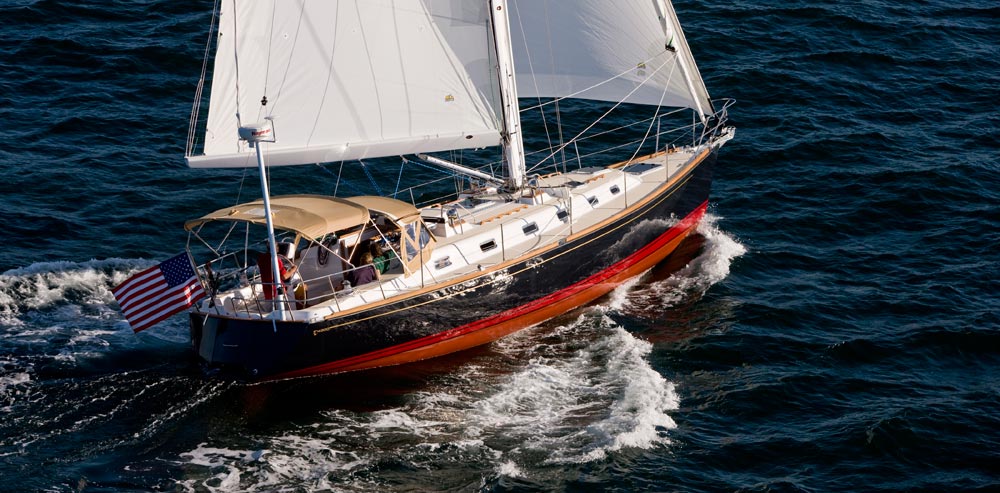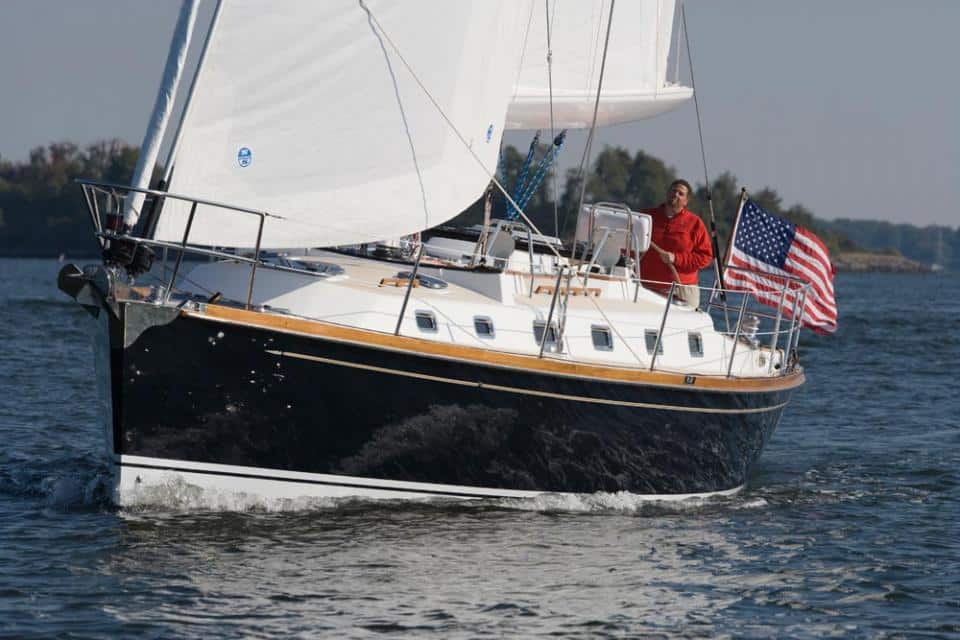
Tim Jackett’s eyebrows seemed raised ever so slightly, and I couldn’t blame him a bit. Jackett is the chief designer and COO of Tartan Yachts, and he was seated beside me as I slid behind the helm of his latest creation-the first Tartan 4300-on a blustery day with gusts in the low 20s last October on Chesapeake Bay. There was a reef in the main, and the 150-percent reacher was set and drawing, and it occurred to me that if I just punched the boat to weather a wee bit, all sorts of truths might be revealed.
As we rolled up from a beam reach to a tight one, things indeed got interesting. Spray began flying, and the heel angle became pronounced. I caught a glimpse of one of Jackett’s associates in the companionway, and forget the raised eyebrows: His peepers were bulging.
But Jackett remained serene, continuing his remarks on the benefits, for performance cruising, of the yacht’s twin forestays, the outer one sporting the aforementioned reacher, the inner one set up with a self-tacking jib. And the boat seemed almost to reflect his mood. The helm was balanced. I had complete control. In many contemporary cruising boats, with their fin keels and blade rudders, this is hardly a given, and round-ups do occur.
At that moment, of course, it all went pear-shaped, though through no fault of Jackett’s or his design: The shackle on the reacher suddenly let go, and the sail tumbled harmlessly to leeward. But the point had been proven, to me at least. The Tartan 4300 is one sweet-sailing ride. And you don’t have to take my word for it-CW’s Boat of the Year judges named it the Best Midsize Luxury Cruiser and the Domestic Boat of the Year.
Why? Let’s start with the rig, a double-spreader Novis Composites carbon-fiber stick that’s light but plenty capable of carrying a load of sail. Jackett is clearly unafraid of piling it on, though he’s done so intelligently, as he’s aware that sail area is a liability if it can’t be controlled; hence the big reacher for off-wind work, which negates the need for spinnakers or asymmetrics, and the self-tending jib for upwind sailing, which makes tacking effortless.
Couple these with a roachy, full-battened main utilizing the sweet Harken Battcar system, which is stashed when furled aboard a Park Avenue-style “pocket boom,” and you’ve got a setup that lends itself well to shorthanded sailing (especially if you go for electric winches).
The counterpoint to that tall spar is the hull and underbody. The 4300’s profile shows a long waterline, minimal overhangs, and the subtlest of sheers. Like all Tartans, the construction for both the hull and deck is a state-of-the-art infused epoxy-composite laminate that’s robust yet relatively light. This allows Jackett to concentrate the weight down low, which of course is another reason that the boat is stiff and steadfast under sail.
There are three keel options: Our test boat had a shallow “beavertail” that’s equipped with a bulb and draws 5 feet 10 inches with 8,775 pounds of ballast; the deep-fin option has a draft of 8 feet 3 inches and ballast weighing 6,750 pounds; the keel centerboard has a board-up draft of 4 feet 10 inches and 9,000 pounds of ballast. Jackett says that performance differences between the three are comparable with sheets eased, although upwind, the deep fin will fare better.
Moving below, there are two accommodation plans. Both feature an impressive owner’s stateroom forward, with a prominent head and shower stall, and a central dining table in the saloon with a big wraparound settee; the portside settee has a pull-out berth extension that converts it to a large double.
The layouts vary in the aft quarters and navigation stations. One model has the fairly traditional twin doubles aft, with the nav station to starboard, opposite the galley. Our test boat, however, featured a single stateroom aft with an athwartships double berth under the cockpit. This is essentially a two-couples layout, one of the benefits of which is a massive storage locker under the port cockpit seat.
This floor plan includes a large, aft-facing desk/navigation area to port, just aft of the U-shaped galley and right at the foot of the companionway. To be honest, at first glance I wasn’t sure what to make of this unusual treatment, where the galley and nav station essentially merge together. But as I sat in the big, swiveling, leather armchair and imagined navigating at sea or addressing paperwork in port-the dedicated spot for a laptop is very nifty-it really began to grow on me. For auxiliary power, the 4300 employs a 56-horsepower Volvo diesel in a saildrive configuration.
There were a lot of other little things on hull number one (some of which were options) that made the 4300 a very cool sailboat, including the cockpit inserts alongside the wheel for stretching out under way, the built-in cockpit drink holders, the excellent belowdecks ventilation (including hatch screens and fans), the manual foot pumps to augment the pressure-water system, the handy door latches, and the excellent engine access.
Of course, being a boat, there were also a few niggling matters, including the dearth of 12-volt outlets and reading lights, a questionable aft (not amidships) placement of the lifeline gates, a low overhead to the aft stateroom, and the rather large-diameter wheel. Don’t get me wrong, I loved the wheel, but I also stand over 6 feet tall. By my very rough calculations, anyone shorter than 5 feet 10 inches may have a tough time peering over it.
All in all, however, I found the Tartan 4300 to be a worthy addition to the fleet of one of the great names in American boatbuilding. I’m not sure Tim Jackett will allow me to steer another one anytime soon, but he shouldn’t worry. Clearly, his boats are tougher than I am.
Herb McCormick is a Cruising World editor at large.

Each time the BOTY judges begin their dockside inspection of a boat, the builder is asked to outline its design brief. In the case of the Tartan 4300, designer Tim Jackett hit the nail on the head when he said that the company’s latest hull is well suited to take a couple on an extended coastal cruise and, on occasion, a sail well offshore.
In fact, by the time our test sail on the 4300 came to an end a couple of days later, our judges concluded that the builder had matched the design brief so perfectly that they had no choice but to name the 4300 as the Best Midsize Luxury Cruiser as well as the 2008 Domestic Boat of the Year.
This is a boat that’s fitted out on deck for serious sailing and below for sumptuous comfort. A solent rig provides a large reacher for off-the-wind performance and a self-tending staysail that makes shorthanded tacking simple. Lifeline stanchions are solid, with fairleads welded to their bases to handle furling lines. The cockpit is well laid out, with large primary winches located close to the helm. The dodger is ample and appreciated in a blow, and a door in the boat’s transom folds down to create a swim platform and a boarding ladder.
Below, the cherry interior woodwork is rich and light. Judge Stacey Collins noted that lights in the aft and forward cabins are ample in number and can be controlled by dimmers to achieve just the right mood for the crew. The nav station at the base of the companionway includes lots of room for instruments and an oversized chair where the skipper can collect his thoughts or join in the conversation in the adjoining saloon.
Under sail in a gusty, 20-knot breeze, the 4300’s motion was steady through the water, and the boat was lively and fun to sail. The only lingering question the judges had once the sails were stowed was “When can we go cruising?”








